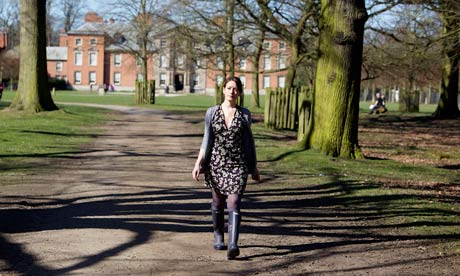
We are walking the main drive at Dunham Massey, past the bulrushes and the deer and the tight, beady buds. Above us, the sky is broad and bright and fierce with the blue of the new spring; greenfinches and chaffinches call out from the bare branches; a buzzard glides quiet and low.
Dunham Massey is a 300-acre park not far from Altrincham, and a short trip from Manchester, though as wildly removed from the metropolis as one could hope. Once home to the Earl of Stamford, it has been owned by the National Trust since 1976. Its main building, a Grade-I listed Georgian hall, houses a collection of Huguenot silver, rare wood carvings, and a selection of portraits by artists such as Sir Joshua Reynolds and William Beechey, as well as telling the story of the house itself – a tale of scandal, remittance men and bareback circus riding.
But it is in its grounds that one finds the true splendour of Dunham Massey. Inside the estate's high brick walls, its gardens and parkland splay out around the main house, an array of architectural oddities, rare wildlife and ancient woodland.
We walk the service road, past the stables, up the slope, to where the watermill stands with its faded blue doors and its silent millstones. Then we take the smooth-lipped steps down to the rust-bellied stream, past the celandines on its bank and brilliant-green lichen clinging to the stone wall. Here the water tumbles from somewhere underground and hidden, and beneath its blazing surface the young sticklebacks swarm to and fro.
Along Langham Grove, past Old Man Pool and the beeches and the sandstone obelisk, we plot the deer sanctuary: the fallow deer stand dun-coloured and skittish in the distance, grazing in the sunshine, tails twitching, heads suddenly aloft at the sound of a shout, a cry, a broken branch.
Right now, the deer – black, common, menil and white – are in the throes of their spring rituals. Jackdaws pluck at their rough winter coats as does head deep into the bracken. Meanwhile, the bucks feast on the rich new grass, their antlers growing: spreading from small, velvety coronets, then becoming the brow, the trey, and finally, the flattened palmation.
Dunham Massey is one of those places that makes the visitor acutely aware of the weight of time; to walk its avenues and groves, past oak trees planted in the 17th century and the lime avenue set out in 1900, is to be reminded of one's own fleeting presence and the fripperies of modern life. And it is restorative, somehow, to stand here beneath these branches, sap rising, slowly coming into leaf, and rejoice in one's own insignificance.
This park is one of the only places in the north-west of England with such a concentration of ancient trees, and they set the pace of the walk somehow: stately, calm and measured. There are pollarded limes, a handkerchief tree, cork oaks and white-stemmed birch. And among them flit chiffchaffs and nuthatches, robins, wrens, treecreepers and jays. There are 500 species of insect here too, including the cobweb beetle and the small tortoiseshell butterfly. There are noctule bats, woodpeckers, and bracket fungus that fans out spectacularly on the fallen tree trunks.
Nearing the house once more, past the lions that guard the gateposts and over the gravel, lie the estate's formal gardens: Britain's largest winter gardens, with its 700 species of plant and 1,600 trees or shrubs, from the fragrant mahonia to the purple-berried callicarpa and the crab apple, the cornus and the Japanese maples. Beyond them lie the Bog Garden, home to irises, ferns and astilbes, a moss garden, hydrangea display, and an Edwardian parterre, as well as a Victorian bark-house and an orangery.
Their quiet order is refreshing – a smooth stretch of grass, a camellia walk, the eye seeking out the bowed and checkered heads of the fritillaries in the sun-dappled shade. And among them dart the twirl-tailed squirrels and the small, slight woodland birds: a glimpse of tail, soft wing, speckled breast, and then the rustle of branches, the flicker of leaves, the "fillip-quit-tereret" of the song thrush, flung out over all those wide acres.

